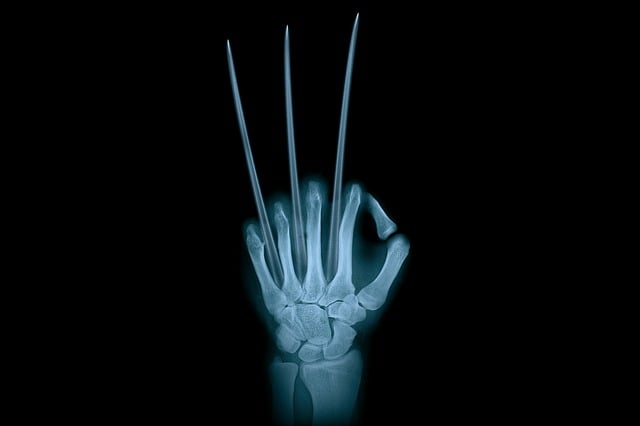Myelography uses X-ray contrast dye injections into cerebrospinal fluid to visualize and diagnose spinal cord conditions like herniated discs or tumors, enhancing imaging of the spinal canal, nerves, and meninges with dyes like iodinated media or gadolinium agents. While carrying risks including radiation exposure, this technique offers crucial insights into spine anatomy, aiding in accurate treatment decisions.
“Unveiling the spinal cord’s intricate architecture requires advanced imaging techniques, and myelography stands as a cornerstone. This article explores the pivotal role of X-ray contrast dye in enhancing the visualization of the spinal cord and its surrounding structures. We delve into the process of myelography, the mechanism behind X-ray contrast dye‘s effectiveness, and the diverse types employed. Additionally, we balance the benefits against potential risks associated with this contrasting agent, offering a comprehensive guide for healthcare professionals.”
Understanding Myelography and Spinal Cord Imaging
Myelography is a specialized imaging technique that plays a pivotal role in visualizing and diagnosing conditions affecting the spinal cord. This procedure involves the injection of a special X-ray contrast dye into the cerebrospinal fluid (CSF), which surrounds and protects the spinal cord and brain. The contrast dye enhances the visibility of the spinal canal, nerves, and surrounding structures on subsequent X-rays or other imaging modalities.
Spinal cord imaging is crucial for detecting various pathologies, such as herniated discs, spinal stenosis, or tumors. By using myelography, healthcare professionals can obtain detailed cross-sectional images of the spinal cord, enabling accurate diagnosis and guiding treatment plans. The contrast dye acts as a marker, highlighting important anatomical features that might otherwise be obscured, making it an indispensable tool in neuroradiology.
Role of X-ray Contrast Dye in Enhancing Visualization
The introduction of X-ray contrast dye plays a pivotal role in myelography, significantly enhancing the visualization of the spinal cord and its surrounding structures. This specialized dye, when injected into the cerebrospinal fluid, acts as a radiant opacifier, allowing radiologists to capture detailed images of the spinal canal, nerve roots, and meninges. The improved contrast between these structures and the surrounding bone and soft tissues enables more precise identification of any anomalies or pathologies that may be present.
X-ray contrast dye facilitates better diagnosis by highlighting potential issues such as herniated discs, spinal stenosis, or inflammation. It also aids in assessing the integrity of the spinal cord itself, making it an indispensable tool for comprehensive spinal cord imaging. The ability to visualize these intricate elements is crucial for healthcare professionals to make accurate decisions regarding treatment and management strategies.
Types of Contrast Media Used in Myelography
In myelography, various types of contrast media are utilized to enhance the visibility of the spinal cord and its surrounding structures on X-ray images. These contrast dyes play a pivotal role in providing detailed insights into the anatomy and pathology of the spine. One commonly used contrast media is iodinated dye, which has high density and readily absorbs X-rays, making it ideal for highlighting the spinal canal, nerves, and blood vessels. Iodine-based contrasts are known for their rapid action, allowing for dynamic imaging during procedures like myelography.
Another type of contrast media employed in spinal cord imaging is gadolinium-based agents. Gadolinium dyes are primarily used in magnetic resonance imaging (MRI) as they enhance the signal intensity of soft tissues, including the spinal cord and its membranes. This enables the visualization of subtle structural changes, such as inflammation or demyelination, that may not be apparent on standard X-ray images. The selection of contrast media depends on the specific clinical indications and the type of imaging technique employed to ensure optimal visualization of the target structures.
Benefits and Risks of Using Contrast Media
The introduction of contrast media, such as X-ray contrast dye, in myelography offers several advantages for spinal cord imaging. It enhances the visibility of the spinal canal and its structures, allowing radiologists to detect abnormalities that might be invisible on plain X-rays. This is particularly beneficial in diagnosing conditions like herniated discs, spinal stenosis, or tumors. The dye also helps in identifying potential leaks or blockages within the nervous system.
However, as with any medical procedure, there are risks associated with using contrast media. Allergic reactions are a potential concern, although rare. Additionally, over-exposure to radiation from repeated X-ray imaging can lead to long-term health issues. It’s crucial for healthcare providers to weigh these risks against the benefits, especially in patients with multiple medical conditions or those requiring frequent spinal cord imaging. Proper monitoring and adherence to safety guidelines are essential to minimize these risks while maximizing the diagnostic value of contrast media in myelography.
Myelography, enhanced by the strategic use of X-ray contrast dye, offers valuable insights into spinal cord health. By selecting appropriate types of contrast media and balancing benefits against risks, healthcare professionals can significantly improve the visualization of spinal structures, leading to more accurate diagnoses and effective treatment planning for a range of neurological conditions.
